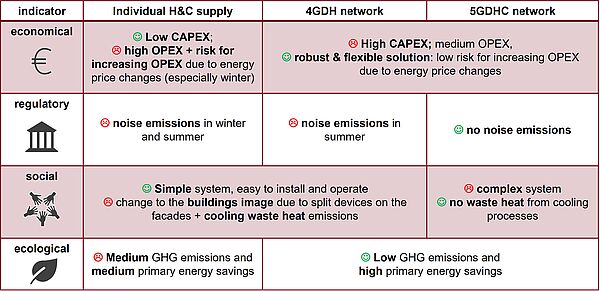The CleanHeatSelector project was funded by the Austrian Research Promotion Agency (FFG) with funds from the BMLUK as part of the "Energie.Frei.Raum - 3. Ausschreibung" research funding programme and ran from January 2024 to June 2025. The aim of the project was to develop an integrated digital decision-making tool for the technology-neutral selection of renewable heating and cooling systems at building and neighbourhood level. CleanHeatSelector was coordinated by the AIT Austrian Institute of Technology and carried out together with two scientific partners, who analysed the legal and spatial planning framework conditions and integrated them into the tool
Project goals
The main objectives of CleanHeatSelector are:
- The development of an integrated decision-making tool for the technology-neutral selection of renewable energy-based heating and cooling systems at building and neighbourhood level
- The integration of legal, economic, ecological and social evaluation criteria to develop a practice-orientated tool for planners, municipalities and decision-makers
CleanHeatSelector includes the following activities:
- Analysing the legal framework and spatial planning instruments in the context of the transformation of heating and cooling systems
- Developing methods for the integrated assessment of technical supply solutions, taking into account energy demand, renewable energy potential, land availability and existing infrastructure
- Systematic consideration of risks as part of the assessment of potential supply solutions
- The development and testing of a user-centred, interactive concept ("proof of concept") that identifies suitable options open to all technologies and enables a comprehensible evaluation
- Validation of the tool using real case studies with a particular focus on legal feasibility, technical feasibility and planning integration
Case studies: City neighbourhood in Vienna and the city of Baden near Vienna (Austria)
In the CleanHeatSelector project, AIT was responsible for coordinating the consortium and for the techno-economic evaluation of heating and cooling systems, including a systematic risk assessment.
The contribution included in particular
- the development of an integrated modelling approach
- to determine building-specific useful energy requirements using City Energy Analyst (CEA) in combination with regression methods
- to derive technology-dependent final energy demand profiles for various supply solutions, taking into account several weather years, extreme climate conditions and climatic changes
- for the techno-economically optimal dimensioning and operational optimisation of decentralised and grid-connected systems using the internal optimisation framework IESopt
- the integration of sensitivity analyses using Monte Carlo simulations in order to systematically capture uncertainties in the planning context, including
- the identification of relevant parameters influencing the system performance and economic efficiency of heating and cooling solutions
- defining realistic bandwidths for these parameters with regard to future developments (e.g. frequency of extreme weather events)
- the integration of sensitivity analyses into the long-term optimisation of supply system operations
Project results
Summary in preparation. Previous publications:
- IEWT 2025:
- Energy space planning 2.0" concept: Evaluation of heating and cooling technologies based on economic, regulatory, ecological and social factors (Abstract, Presentation)
- Methodik für die technisch-wirtschaftliche Analyse von Wärme- und Kühllösungen auf Quartiersebene unter Berücksichtigung von Unwägbarkeiten (Abstract, Presentation)
![[Translate to English:] Digitalisation and HVAC Technologies Symbolfoto: Das AIT ist Österreichs größte außeruniversitäre Forschungseinrichtung](/fileadmin/_processed_/8/1/csm_GettyImages-18655_5a3dffca27.jpg)





